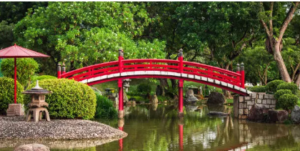The Himeji Garden in Adelaide’s southern parklands was established in 1982 to commemorate Adelaide’s Sister City’s relationship with the city of Himeji. A careful blend of Japanese aesthetics with climate-appropriate plant selections makes this a tranquil space.
The Himeji garden includes paths that allow visitors to meander through the landscape. Using paths can help you to zone your garden, prompt contemplation and bring visitors into your garden spaces. For more information about the Japanese garden design in Adelaide, click here.
Plants
 Many plants in Japanese gardens are evergreen, focusing on leaf texture and form rather than flowers. Australian natives like Correa (Correa alba), banksias such as Davidson’s plum (Banksia elata) and pygmy gum (Eucalyptus obliqua) are suitable for a Japanese garden, along with ferns that add textural interest to the understory.
Many plants in Japanese gardens are evergreen, focusing on leaf texture and form rather than flowers. Australian natives like Correa (Correa alba), banksias such as Davidson’s plum (Banksia elata) and pygmy gum (Eucalyptus obliqua) are suitable for a Japanese garden, along with ferns that add textural interest to the understory.
Whenever possible, water features are used to represent the fundamental forces of life and nature. A pond or simple waterfall can be integrated into the garden, or raked gravel and pebbles can suggest a river or stream. A bridge can cross over the feature, or it could be a row of low stepping stones.
The Himeji garden in Adelaide’s southern Park Lands was built to commemorate the city’s Sister City’s relationship with Himeji, Japan. Its flora is a thoughtful mix of traditional Japanese varieties and climate-appropriate options. Plants such as azaleas, rhododendrons, ferns, and ornamental grasses help to create the calm atmosphere of a Japanese garden.
Paths
Japanese gardens rely on meandering garden path ideas to encourage contemplation while strolling through the landscape. They also serve to reveal new features and views at each twist and turn. If you do incorporate a pathway into your garden design, be sure to lay it carefully to minimise the impact on surrounding plants and ensure that wheelchair users can traverse it.
Artificial elements of the garden should always appear to be natural and serve a purpose that reflects Japanese philosophy. For example, a timber bridge might be carefully placed to cross over a bed of stones or gravel that symbolises water.
Black is an effective colour to use in Japanese garden designs, as it will highlight the lush foliage of many plants and cast a moody backdrop. It can be complemented with black furniture or garden wall ideas clad in charred timber to create a more modern aesthetic.
Structures
Japanese gardens are characterised by the use of water and structures that reflect nature in miniature. A pond is often at the heart of the garden, where it symbolises purity, renewal and the fluidity of life. A raked gravel path adds to the sense of movement and serenity, while stone bridges connect different parts of the garden, evoking the concept of journey.
Rocks, often representing mountains or islands, have substantial symbolic value in Japan and are carefully arranged to create natural-looking formations. Moss and cherry blossoms are also frequently featured, with pruning and shaping essential to their beauty. Tea houses (chashitsu) and stone lanterns are also standard features of Japanese gardens, offering spaces for meditation or tea ceremonies.
Visiting Japan is the ultimate inspiration for those interested in building a Japanese garden, but it is possible to incorporate some elements into a small space. For example, a simple backyard could feature a zen garden with a pond, waterfall and bamboo fencing to offer visual and spatial seclusion. For more information about the Japanese garden design in Adelaide, click here.
Lighting
The power of rocks in Japanese gardens is often heightened by placing them near water features where they create reflections and can be framed by clumps of ground cover ferns or grasses. Moss and lichen are encouraged to grow on the surface and add texture.
Adding a bridge to your garden is another crucial way of creating a movement around your Japanese-inspired landscape. Bridges can symbolise a transition from the mundane world of humans to a higher spiritual realm of nature and purity. They can also be used to create a focal point or a place of rest and contemplation.
